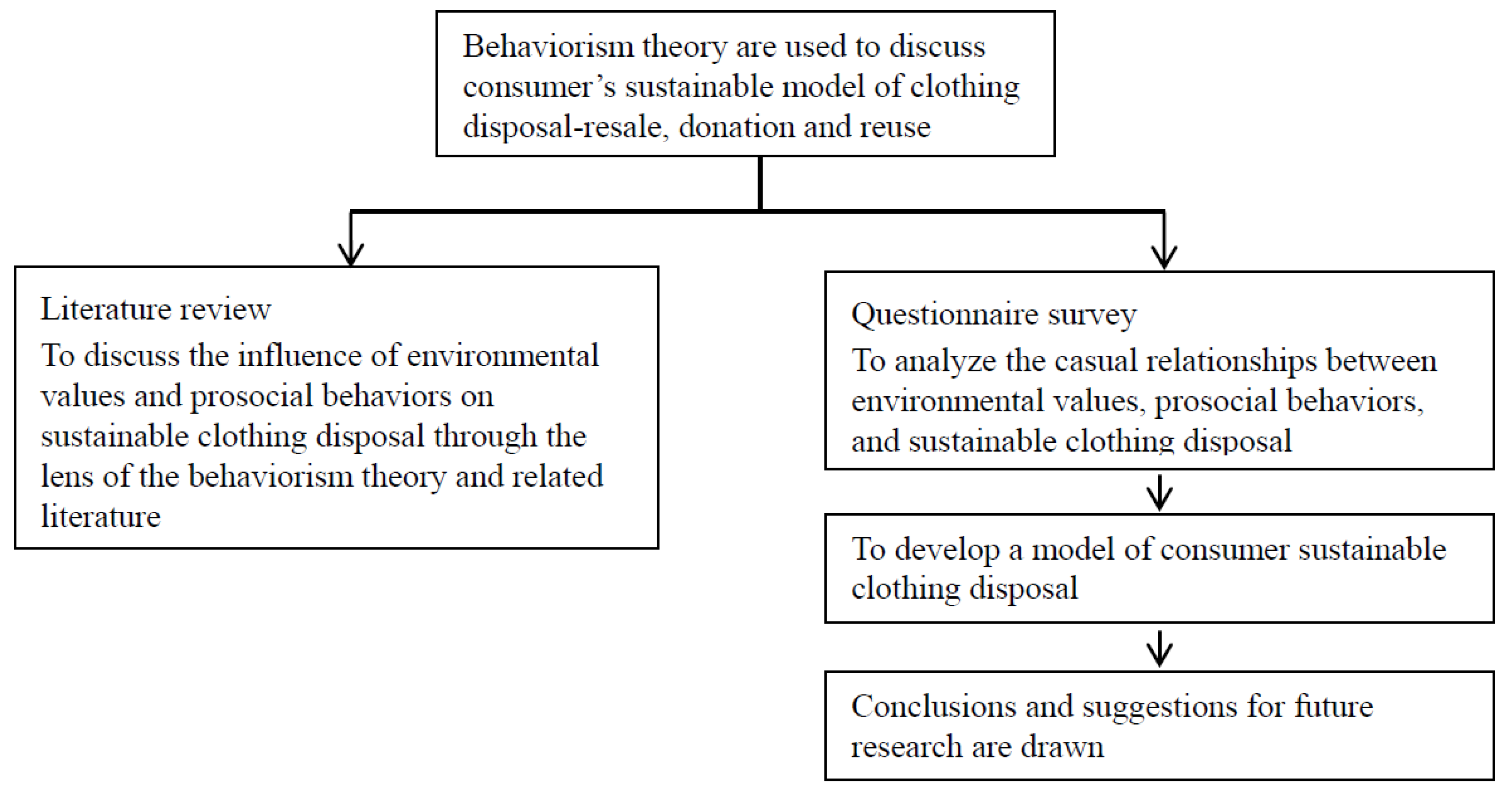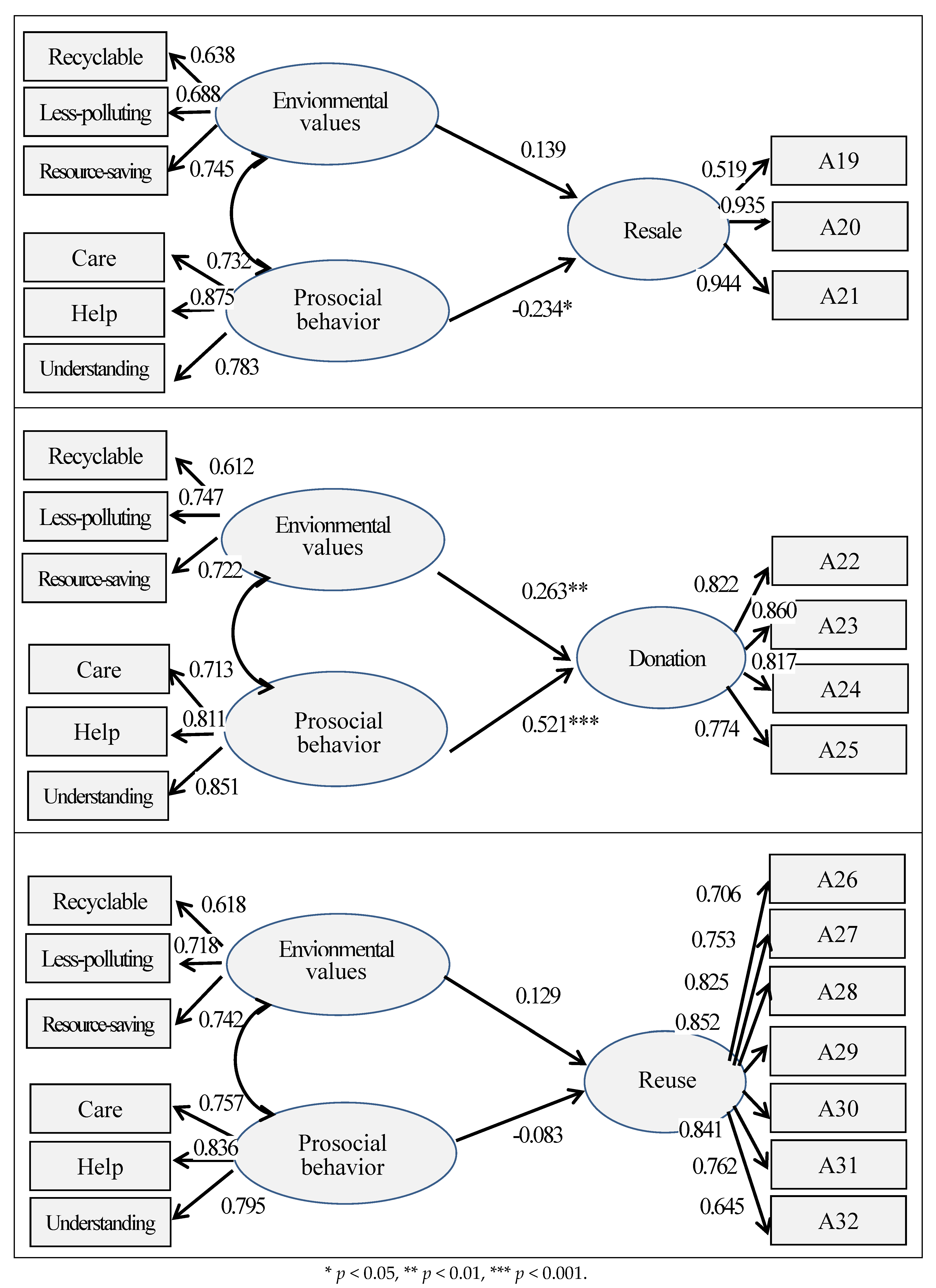Clothing Disposal Behavior of Taiwanese Consumers with Respect to Environmental Protection and Sustainability
Abstract
1. Introduction
2. Literature Review
2.1. The Environmental Crisis of the Clothing Industry
2.2. Sustainable Clothing Disposal Behavior
2.3. Behaviorism Theory
2.4. Environmental Values
2.5. Prosocial Behavior
3. Research Methods
3.1. Research Procedure
3.2. Research Framework
3.3. Instruments Development
3.4. Participants
3.5. Data Analysis
4. Results and Discussion
4.1. Reliability and Validity
4.2. Results
4.3. Discussion
5. Conclusions
Author Contributions
Funding
Conflicts of Interest
References
- Peng, H.-C. 438 Pieces of Clothing Are Discarded Per Minute in TAIWAN. Available online: https://www.gvm.com.tw/article.html?id=41699 (accessed on 16 July 2019).
- Fu, H.-Y. Prosocial Behavior Affect the Intention to Energy Saving and Carbon Reduction Action: A Perspective of the Theory of Planned Behavior. Ph.D. Thesis, National Taiwan Normal University, Taipei, Taiwan, 2015. [Google Scholar]
- Watson, J.B. Psychology as the behaviorist views it. Psycho. Rev. 1913, 20, 158–177. [Google Scholar] [CrossRef]
- Cheunga, M.F.Y.; To, W.M. An extended model of value-attitude-behavior to explain Chinese consumers’ green purchase behavior. J. Retail. Consum. Serv. 2019, 50, 145–153. [Google Scholar] [CrossRef]
- Putri, P.A.S.; Srimulyo, K. The effects of social media use on the increase of the quality of learning and teaching activities at senior high school. J. Talent Dev. Excell. 2020, 12, 261–266. [Google Scholar]
- Jung, S.; Jin, B. Sustainable development of slow fashion businesses: Customer value approach. Sustainability 2016, 8, 540. [Google Scholar] [CrossRef]
- Rana, S.; Pichandi, S.; Karunamoorthy, S.; Bhattacharyya, A.; Parveen, S.; Fangueiro, R. Carbon footprint of textile and clothing products. In Handbook of Sustainable Apparel Production; CRC Press: Boca Raton, FL, USA, 2015; pp. 141–166. ISBN 978-1482299373. Available online: https://books.google.com.tw/books?hl=zh-TW&lr=&id=-TGsCQAAQBAJ&oi=fnd&pg=PP1&dq=Handbook+of+Sustainable+Apparel+Production&ots=QyJtwOmc3R&sig=moqeBIQjQemKQzNub7T1Y7FMtss&redir_esc=y#v=onepage&q=Handbook%20of%20Sustainable%20Apparel%20Production&f=false (accessed on 21 February 2020).
- United Nations World Commission on Environment and Development (WCED) Our Common Future Report. 1987. Available online: https://www.encyclopedia.com/environment/energy-government-and-defense-magazines/united-nations-world-commission-environment-and-development-wced-our-common-future-report-1987 (accessed on 20 July 2019).
- Joung, H.-M.; Park-Poaps, H. Factors motivating and influencing clothing disposal behaviours. Int. J. Consum. Stud. 2011, 37, 105–111. [Google Scholar] [CrossRef]
- Bianchi, C.; Birtwistle, G. Consumer clothing disposal behavior: A comparative study. Int. J. Consum. Stud. 2012, 36, 335–341. [Google Scholar] [CrossRef]
- Weber, S.; Lynes, J.; Young, S.B. Fashion interest as a driver for consumer textile waste management: Reuse, recycle or disposal. Int. J. Consum. Stud. 2016, 41, 207–215. [Google Scholar] [CrossRef]
- Suar, D.; Khuntia, R. Influence of personal values and value congruence on unethical practices and work behavior. J. Bus. Ethics 2010, 97, 443–460. [Google Scholar] [CrossRef]
- Skinner, B.F. About Behaviorism; Knopf Doubleday Publishing Group: New York, NY, USA, 1976; pp. 163–183. ISBN 0-394-71618-3. Available online: https://books.google.com.tw/books?hl=zh-TW&lr=&id=K7WKkwPzNqsC&oi=fnd&pg=PA3&dq=About+behaviorism&ots=3h_Nk2Chvd&sig=oxe5obwpKYQb8jDMY-JhESqtVnY&redir_esc=y#v=onepage&q=About%20behaviorism&f=false (accessed on 22 February 2020).
- Dominicis, S.D.; Schultz, P.W.; Bonaiuto, M. Protecting the environment for self-interested reasons: Altruism is not the only pathway to sustainability. Front. Psychol. 2017, 8, 1065. [Google Scholar] [CrossRef]
- Mondal, P. The Meaning and Functions of Social Values. Available online: https://www.yourarticlelibrary.com/sociology/the-meaning-and-functions-of-social-values-sociology/8522 (accessed on 23 July 2019).
- Schwartz, S.H.; Bilsky, W. Toward a universal psychological structure of human values. J. Pers. Soc. Psychol. 1987, 53, 550–562. [Google Scholar] [CrossRef]
- Speth, J.G.; Martin, G.T. The Bridge at the Edge of the World: Capitalism, the Environment, and Crossing from Crisis to Sustainability; Yale University Press: New Haven, CT, USA, 2008; Available online: http://rachel.org/?q=es/node/6956/print (accessed on 10 March 2020).
- Li, J.; Ai, W. Examining environmental protection by the thought of the unity of heaven and man. Environ. Dev. 2018, 3, 209–211. [Google Scholar]
- Shim, S. Environmentalism and consumers’ clothing disposal patterns: An exploratory study. Cloth. Text. Res. J. 1995, 13, 38–48. [Google Scholar] [CrossRef]
- Lehner, M.; Mont, O.; Mariani, G.; Mundaca, L. Circular economy in home textiles: Motivations of IKEA consumers in Sweden. Sustainability 2020, 12, 5030. [Google Scholar] [CrossRef]
- Paras, M.K.; Ekwall, D.; Pal, R.; Curteza, A.; Chen, Y.; Wang, L. An exploratory study of Swedish charities to develop a model for the reuse-based clothing value chain. Sustainability 2018, 10, 1176. [Google Scholar] [CrossRef]
- Bukhari, M.A.; Carrasco-Gallego, R.; Ponce-Cueto, E. Developing a national programme for textiles and clothing recovery. Waste Manag. Res. 2018, 36, 321–331. [Google Scholar] [CrossRef]
- Morgan, L.R.; Birtwistle, G. An investigation of young fashion consumers’ disposal habits. Int. J. Consum. Stud. 2009, 33, 190–198. [Google Scholar] [CrossRef]
- Jones, E.E.; Colman, A.M. Social psychology. In The Social Science Encyclopedia, 2nd ed.; Kuper, A., Kuper, J., Eds.; Routledge: London, UK, 1996; pp. 797–800. ISBN 0-415-10829-2. Available online: https://scholar.google.com.tw/scholar?hl=zh-TW&as_sdt=0%2C5&q=Social+psychology&btnG= (accessed on 25 February 2020).
- Graziano, W.G.; Eisenberg, N. Agreeableness: A dimension of personality. In Handbook of Personality Psychology; Academic Press: Cambridge, MA, USA, 1997; pp. 795–824. ISBN 978-0121346454. [Google Scholar]
- Midgett, C.; Bendickson, J.S.; Muldoon, J.; Solomon, S.J. The sharing economy and sustainability: A case for Airbnb. Small Bus. Inst. J. 2017, 13, 51–71. [Google Scholar] [CrossRef]
- Shah, R.; Pillai, P. Consumer’s environmental concern & its influence on their purchase intention: SEM Approach. Int. J. Manag. 2012, 2, 24–31. [Google Scholar]
- Cruz-Cárdenas, J.; Guadalupe-Lanas, J.; Velín-Fárez, M. Consumer value creation through clothing reuse: A mixed methods approach to determining influential factors. J. Bus. Res. 2019, 101, 846–853. [Google Scholar] [CrossRef]
- Gwozdz, W.; Nielsen, K.S.; Müller, T. An environmental perspective on clothing consumption: Consumer segments and their behavioral patterns. Sustainability 2017, 9, 762. [Google Scholar] [CrossRef]
- Morais, C.; Montagna, G. Customized wardrobe: Clothing according to user. Procedia Manuf. 2015, 3, 5814–5821. [Google Scholar] [CrossRef][Green Version]
- Domina, T.; Koch, K. Consumer reuse and recycling of post-consumer textile waste. J. Fash. Mark. Manag. Int. J. 1999, 3, 346–359. [Google Scholar] [CrossRef]
- Hwang, Y.Y.; Jo, G.Y.; Oh, M.J. The persuasive effect of competence and warmth on clothing sustainable consumption: The moderating role of consumer knowledge and social embeddedness. Sustainability 2020, 12, 2661. [Google Scholar] [CrossRef]
- Geiger, S.M.; Keller, J. Shopping for clothes and sensitivity to the suffering of others: The role of compassion and values in sustainable fashion consumption. Environ. Behav. 2018, 50, 1119–1144. [Google Scholar] [CrossRef]
- Norum, P.S. Trash, charity, and secondhand stores: An empirical analysis of clothing disposition. Fam. Consum. Sci. Res. J. 2015, 44, 21–36. [Google Scholar] [CrossRef]
- Koch, K.; Domina, T. Consumer textile recycling as a means of solid waste reduction. Fam. Consum. Sci. Res. J. 2009, 28, 3–17. [Google Scholar] [CrossRef]
- Sonnenebrg, N.C.; Marx-Pienaar, J.M.M.; Stols, M.J. Female consumer’s apparel disposal behaviour in the South African emerging market context. Waste Manag. Environ. 2019, 231, 281–285. [Google Scholar] [CrossRef]
- Carlo, G.; Randall, B.A. The development of a measure of prosocial behaviors for late adolescents. J. Youth Adolesc. 2002, 3, 31–44. [Google Scholar] [CrossRef]
- Niinimäki, K.; Hassi, L. Emerging design strategies in sustainable production and consumption of textiles and clothing. J. Clean. Prod. 2011, 19, 1876–1883. [Google Scholar] [CrossRef]
- Kerlinger, F.N.; Lee, H.B. Foundations of Behavioral Research, 4th ed.; Wadsworth Publishing: Marceline, MO, USA, 2000; pp. 163–190. ISBN 0-15-507897-6. Available online: https://www.semanticscholar.org/paper/%E0%B8%9A%E0%B8%97%E0%B8%A7%E0%B8%B4%E0%B8%88%E0%B8%B2%E0%B8%A3%E0%B8%93%E0%B9%8C%E0%B8%AB%E0%B8%99%E0%B8%B1%E0%B8%87%E0%B8%AA%E0%B8%B7%E0%B8%AD-%22Foundations-of-Behavioral-The-By-%E0%B8%9E%E0%B8%B1%E0%B8%99%E0%B8%98%E0%B8%B8%E0%B8%A1%E0%B8%99%E0%B8%B2%E0%B8%A7%E0%B8%B4%E0%B8%99/6e29ee2617666451edf1a2a43786d3fb68ff21b1?p2df (accessed on 7 March 2020).
- Nunnally, J.C. Psychometric Theory—25 Years Ago and Now. Educ. Res. 1975, 4, 7–21. [Google Scholar] [CrossRef]
- Browne, M.W.; Cudeck, R. Alternative ways of assessing model fit. Sociol. Methods Res. 1992, 21, 230–258. [Google Scholar] [CrossRef]
- Bagozzi, R.P.; Yi, Y. On the evaluation for structural equation models. J. Acad. Mark. Sci. 1988, 16, 74–94. [Google Scholar] [CrossRef]
- Fornell, C.; Larcker, D.F. Evaluating structural equation models with unobservable variables and measurement error. J. Mark. Res. 1981, 18, 39–50. [Google Scholar] [CrossRef]
- Hair, J.F.; Black, W.C.; Babin, B.J.; Anderson, R.E. Multivariate Data Analysis, 5th ed.; Prentice Hall College Div.: Upper Saddle River, NJ, USA, 1998; pp. 91–150. ISBN 978-0138948580. Available online: https://pdfs.semanticscholar.org/6885/bb9a29e8a5804a71bf5b6e813f2f966269bc.pdf (accessed on 11 March 2020).


| Variables | χ2/df | GFI | AGFI | IFI | NNFI | CFI | RMSEA |
|---|---|---|---|---|---|---|---|
| Environmental values | 3.463 | 0.958 | 0.922 | 0.946 | 0.918 | 0.946 | 0.078 |
| Prosocial behavior | 2.787 | 0.965 | 0.935 | 0.971 | 0.956 | 0.971 | 0.066 |
| Sustainable behavior | 3.856 | 0.907 | 0.867 | 0.942 | 0.928 | 0.942 | 0.084 |
| Latent Variables | Observational Variables | Convergent Validity | ||
|---|---|---|---|---|
| Loading | CR | AVE | ||
| Environmental values | ||||
| Recyclable | A1 | 0.730 | 0.768 | 0.528 |
| A2 | 0.813 | |||
| A3 | 0.624 | |||
| Less polluting | A4 | 0.661 | 0.626 | 0.360 |
| A5 | 0.611 | |||
| A6 | 0.520 | |||
| Resource saving | A7 | 0.733 | 0.764 | 0.519 |
| A8 | 0.748 | |||
| A9 | 0.679 | |||
| Prosocial behaviors | ||||
| Care | A10 | 0.767 | 0.795 | 0.564 |
| A11 | 0.731 | |||
| A12 | 0.755 | |||
| Help | A13 | 0.581 | 0.675 | 0.411 |
| A14 | 0.617 | |||
| A15 | 0.717 | |||
| Understanding | A16 | 0.795 | 0.790 | 0.557 |
| A17 | 0.723 | |||
| A18 | 0.718 | |||
| Sustainable behaviors | ||||
| Resale | A19 | 0.508 | 0.854 | 0.676 |
| A20 | 0.967 | |||
| A21 | 0.913 | |||
| Donation | A22 | 0.829 | 0.890 | 0.670 |
| A23 | 0.866 | |||
| A24 | 0.811 | |||
| A25 | 0.763 | |||
| Reuse | A26 | 0.751 | 0.919 | 0.615 |
| A27 | 0.784 | |||
| A28 | 0.806 | |||
| A29 | 0.822 | |||
| A30 | 0.826 | |||
| A31 | 0.801 | |||
| A32 | 0.691 | |||
| Models | χ2/df | GFI | AGFI | IFI | NNFI | CFI | RMSEA |
|---|---|---|---|---|---|---|---|
| Resale | 2.574 | 0.972 | 0.94 | 0.982 | 0.969 | 0.982 | 0.062 |
| Donation | 4.728 | 0.929 | 0.869 | 0.952 | 0.928 | 0.952 | 0.096 |
| Reuse | 3.29 | 0.93 | 0.892 | 0.955 | 0.941 | 0.955 | 0.075 |
| Paths | Unstandardized Coefficients | β | t-Value | p-Value | |
|---|---|---|---|---|---|
| B | S.E. | ||||
| Resale <---Environmental values | 0.319 | 0.272 | 0.139 | 1.175 | 0.24 |
| Resale <---Prosocial behavior | −0.507 | 0.25 | −0.234 | −2.031 * | 0.042 |
| Donation <---Environmental values | 0.425 | 0.162 | 0.263 | 2.624 ** | 0.009 |
| Donation <---Prosocial behavior | 0.788 | 0.152 | 0.521 | 5.178 *** | 0.000 |
| Reuse <---Environmental values | 0.323 | 0.403 | 0.129 | 0.8 | 0.423 |
| Reuse <---Prosocial behavior | −0.184 | 0.347 | −0.083 | −0.532 | 0.595 |
Publisher’s Note: MDPI stays neutral with regard to jurisdictional claims in published maps and institutional affiliations. |
© 2020 by the authors. Licensee MDPI, Basel, Switzerland. This article is an open access article distributed under the terms and conditions of the Creative Commons Attribution (CC BY) license (http://creativecommons.org/licenses/by/4.0/).
Share and Cite
Lai, C.-C.; Chang, C.-E. Clothing Disposal Behavior of Taiwanese Consumers with Respect to Environmental Protection and Sustainability. Sustainability 2020, 12, 9445. https://doi.org/10.3390/su12229445
Lai C-C, Chang C-E. Clothing Disposal Behavior of Taiwanese Consumers with Respect to Environmental Protection and Sustainability. Sustainability. 2020; 12(22):9445. https://doi.org/10.3390/su12229445
Chicago/Turabian StyleLai, Chih-Chun, and Ching-Erh Chang. 2020. "Clothing Disposal Behavior of Taiwanese Consumers with Respect to Environmental Protection and Sustainability" Sustainability 12, no. 22: 9445. https://doi.org/10.3390/su12229445
APA StyleLai, C.-C., & Chang, C.-E. (2020). Clothing Disposal Behavior of Taiwanese Consumers with Respect to Environmental Protection and Sustainability. Sustainability, 12(22), 9445. https://doi.org/10.3390/su12229445





